Notes: Halewood station was situated on the Cheshire Lines Committee (CLC) main line between Liverpool and Manchester. The CLC was a joint railway formed on 5 July 1865 by the Great Northern Railway (GNR) and the Manchester Sheffield & Lincolnshire Railway (MS&LR). On 18 July 1866 the Midland Railway (MR) also became a partner. The CLC partners were dissatisfied with arrangements they had for reaching Liverpool via the Warrington & Stockport and the Garston & Warrington lines which had become part of the London & North Western Railway
 |
(LNWR) by 1864. The LNWR did all that it could to make things difficult for the CLC. It was for that reason that they promoted a direct line of their own between Cressington Junction (Garston) and Throstle Nest Junction (Trafford) which was granted an Act on 5 July 1865. At Cressington the line connected with the Garston and Liverpool Railway which had already |
become CLC and at Throstle Nest with the CLC mid Cheshire line that provided access to Manchester. A CLC through route between the two cities was thereby created which opened on 2 September 1873. The 1865 Act also made provision for a spur from Glazebrook to Skelton Junction which linked with another CLC line and gave the MR direct access to Liverpool avoiding Manchester. It opened with the section of line from Glazebrook to Cressington Junction a month earlier than the main line on 1 August 1873.
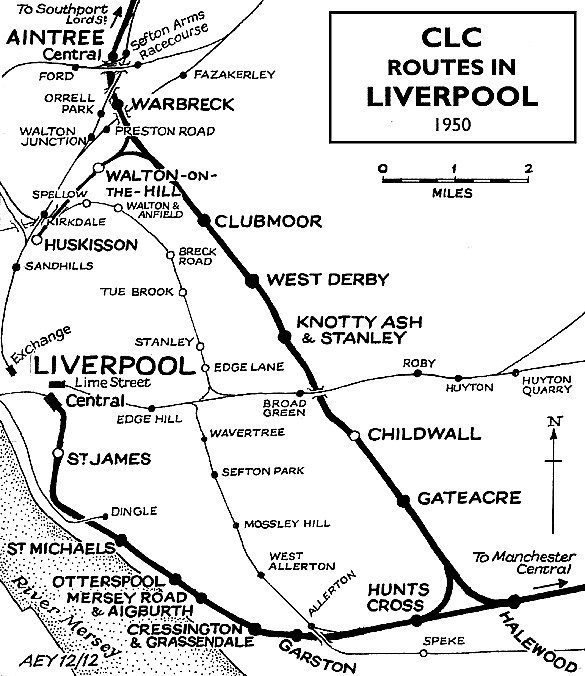 |
Halewood station opened the following year and first appeared in the timetable in May 1874. It was located on the south side of the village of Halewood on the west side of Baileys Lane over which the line passed on a three-arched sandstone viaduct. The station was high up on an embankment, and for this reason it was constructed from timber (unlike nearly all of the other CLC stations which were palatial brick structures). The line was double-track and the station was provided with two platforms. Austere single-storey timber buildings with shallow, hipped roofs and flat awnings were located on each platform. A footbridge was provided at the east end of the station.
Access to the platforms was via a sloping path that led up from Leathers Lane to the up platform. Passengers crossed to the down platform via a barrow crossing. .
| At the time of opening Halewood was served mainly by local stopping trains. Some of these trains ran all the way between Liverpool and Manchester or Stockport, and others went east only as far as Warrington. A new terminus, Liverpool Central, had opened at the western end of the line on 2 March 1874, but at the eastern end the CLC had to run its trains into Manchester |
 |
London Road, a joint LNWR/MS&LR station. (The CLC opened a station of their own, Manchester Central, on 1 July 1880).
The CLC partners had their access to Liverpool but by the 1870s new docks, capable of accommodating larger ships, were being created on the north side of the city; the CLC wanted access to these docks. Although the docks were only a few miles to the north of Liverpool Central, to build a line directly to them would involve expensive tunnelling under the city centre. A cheaper alternative was to build a line to the east of the city from Halewood via Gateacre, Knotty Ash, West Derby and Walton to Aintree. From Walton a branch would run down to the north docks at Huskisson. The line was authorised on 30 July 1874 as the North Liverpool Extension Line.
The North Liverpool Extension Line connected to the main line west of Halewood station. It had two connections: an east-facing junction (Halewood East Junction) 6 chains to the west of the station and a west-facing junction (Hunts Cross East Junction) 1 mile 9 chains to the west. The lines from each of the junctions converged at Halewood North Junction which was 75 chains from Halewood station via the east-facing junction. A triangle was therefore created at Halewood, and sidings were laid within it to facilitate the operation of goods trains.
The North Liverpool Extension Line opened between Halewood and Walton-on-the-Hill on 1 December 1879. On 1 July 1880 the line to Huskisson opened, and goods services began to operate on the North Liverpool Extension Line. The line between Halewood East Junction and Hunts Cross West Junction was quadrupled in 1883.
 |
At first Halewood station was not served by direct passenger services to or from the North Liverpool Extension Line although race-day specials to Aintree did operate. This changed on 1 September 1884 when the Southport & Cheshire Lines Extension Railway (S&CLER) opened between Aintree and Southport Lord Street. Passenger services were operated |
between Southport and Manchester, and many of them called at Halewood.
By December 1895 Halewood was served by fifteen up and fifteen down trains Monday-to-Friday as shown in the table below. On Sundays there were five trains in each direction.
| Up Trains December 1895 |
Destination |
Down Trains December 1895 |
Destination |
| 5.48am |
London Kings Cross |
7.33am |
Southport Lord Street |
| 7.50am |
Warrington Central |
8.26am |
Liverpool Central |
| 8.20am |
Padgate |
8.51am |
Liverpool Central |
| 9.58am |
Godley |
9.35am |
Liverpool Central |
| 1.04pm |
Warrington Central |
11.10am |
Liverpool Central |
| 2.19pm |
Warrington Central |
12.27pm |
Liverpool Central |
| 3.14pm |
Widnes Central |
1.35pm |
Liverpool Central |
| 4.25pm |
Tanhouse Lane |
2.36pm |
Liverpool Central |
| 5.05pm |
Godley |
4.29pm |
Liverpool Central |
| 5.18pm |
Warrington Central |
5.25pm |
Liverpool Central |
| 6.02pm |
Warrington Central |
6.11pm |
Liverpool Central |
| 7.06pm |
Warrington Central |
6.26pm |
Southport Lord Street |
| 7.30pm |
Widnes Central |
7.32pm |
Liverpool Central |
| 9.13pm |
Warrington Central |
8.25pm |
Liverpool Central |
| 11.30pm |
Manchester Central |
9.55pm |
Liverpool Central |
| |
|
10.48pm (Saturdays Only) |
Liverpool Central |
Halewood was advertised in the timetables as an interchange point for passengers travelling between the main line and the Southport line. On 1 August 1897 the MS&LR changed its name to the Great Central Railway (GCR).
In 1897 a new spur was opened between Halewood East Junction and Halewood North Junction to the east of the original line. The line was provided primarily for passenger services and fast freight. The original line became a freight-only line, and the arrangement created a triangle within a triangle.
By the early 1900s a footbridge had been provided at the east end of the station. The line was a busy main line railway and the CLC obviously had concerns about passengers having to cross it to reach the down platform.
The July 1922 timetable showed Halewood as having eighteen up and twenty-one down trains on Monday-to-Friday as shown in the table below. There were four in each direction on the main line only on Sundays.
| Up Trains July 1922 |
Destination |
Down Trains July 1922 |
Destination |
| 5.35am |
Widnes Central |
6.10am |
Liverpool Central |
| 6.55am |
Tanhouse Lane |
7.10am |
Southport Lord Street |
| 7.55am |
Warrington Central |
7.35am |
Garston |
| 8.35am |
Manchester Central |
8.12am |
Liverpool Central |
| 9.09am |
Warrington Central |
8.28am |
Liverpool Central |
| 10.01am |
Stockport Tiviot Dale |
8.55am |
Liverpool Central |
| 11.04am |
Warrington Central |
9.41am |
Liverpool Central |
| 12.07pm |
Godley |
10.30am |
Southport Lord Street |
| 1.10pm |
Warrington Central |
11.31am |
Liverpool Central |
| 1.25pm |
Warrington Central |
11.49am |
Southport Lord Street |
| 3.03pm |
Warrington Central |
12.35pm |
Liverpool Central |
| 4.18pm |
Tanhouse Lane |
1.40pm |
Liverpool Central |
| 5.02pm |
Warrington Central |
2.50pm |
Liverpool Central |
| 5.46pm (Saturdays Only) |
Warrington Central |
4.34pm |
Liverpool Central |
| 5.51pm (Saturdays Excepted) |
Warrington Central |
5.30pm |
Liverpool Central |
| 6.57pm |
Warrington Central |
6.27pm |
Liverpool Central |
| 8.34pm |
Manchester Central |
7.14pm |
Liverpool Central |
| 8.57pm |
Stockport Tiviot Dale |
7.32pm |
Liverpool Central |
| 10.14pm |
Manchester Central |
8.42pm |
Liverpool Central |
| |
|
9.35pm |
Liverpool Central |
| |
|
10.41pm |
Liverpool Central |
On the 1 January 1923 the majority of the railway companies of Great Britain were grouped into the ‘Big Four’. The CLC remained independent, but its parent companies became the London Midland Scottish Railway (LMS) with one-third of the shares and the London & North Eastern Railway (LNER) with two-thirds. The footbridge was removed in the 1920s. A footpath was created that ran from the down platform to the station entrance by passing under the line at the Baileys Lane bridge. The LMS summer 1932 timetable showed Halewood as having ten trains to Liverpool, three to Mananchester, two to Southport and nine to Warrington on weekdays. On Sundays there were three up and five down trains.
| During the Second World War passenger services were cut back, but the line was extremely busy with freight and also with troop trains. The North Liverpool Extension Line was especially so as it linked with the north Liverpool docks. Extra sidings were laid out within the Halewood triangle to accommodate the extra traffic. |
 |
On 1 January 1948 the CLC became part of British Railways London Midland Region. The 1949 summer timetable showed Halewood as having fifteen up and fifteen down trains Monday-to-Friday as seen in the table below. There were no trains on Sundays.
| Up Trains Summer 1949 |
Destination |
Down Trains Summer 1949 |
Destination |
| 6.54am |
Tanhouse Lane |
7.10am |
Liverpool Central |
| 7.02am |
Manchester Central |
7.44am |
Liverpool Central |
| 7.55am |
Warrington Central |
8.01am |
Liverpool Central |
| 8.16am |
Manchester Central |
8.28am |
Liverpool Central |
| 8.28am |
Manchester Central |
8.55am |
Liverpool Central |
| 9.15am |
Warrington Central |
9.43am (Saturdays Only) |
Liverpool Central |
| 10.26am |
Warrington Central |
10.43am |
Liverpool Central |
| 11.59am |
Stockport Tiviot Dale |
12.35pm |
Liverpool Central |
| 1.01pm (Saturdays Only) |
Warrington Central |
2.25pm (Saturdays Only) |
Liverpool Central |
| 1.12pm |
Warrington Central |
2.38pm (Saturdays Excepted ) |
Liverpool Central |
| 1.24pm |
Warrington Central |
3.55pm |
Southport Lord Street |
| 2.29pm |
Warrington Central |
4.29pm |
Liverpool Central |
| 5.09pm |
Stockport Tiviot Dale |
5.40pm |
Liverpool Central |
| 5.24pm |
Warrington Central |
6.38pm |
Liverpool Central |
| 6.08pm (Saturdays Excepted ) |
Manchester Central |
7.40pm (Saturdays Excepted ) |
Liverpool Central |
| 7.07pm |
Warrington Central |
9.42pm |
Liverpool Central |
| 9.06pm (Saturdays Only) |
Warrington Central |
10.32pm |
Liverpool Central |
The CLC lines were very busy at this time but Halewood station, which served only a small village, was unremunerative. British Railways closed it completely on 17 September 1951. Being a timber station its demolition left little trace. On 7 January 1952 the line between Aintree and Southport closed to passenger services. Passenger trains continued to pass between Halewood East Junction and Halewood North Junction as part of a Manchester Central – Aintree Central service until 5 November 1960, but after that date it was used only by race-day specials and excursions. A new signal box had opened in between the main line and the Halewood North spur on 21 October 1962.
 |
Despite the investment in the new signal box the 1960s saw a reversal in the fortunes of the North Liverpool Extension Line. It closed from Aintree to Fazakerley South Junction on 22 September 1968. The 1897 chord between Halewood East Junction and Halewood North Junction closed on 26 October 1968. The sidings and inner triangle had closed a year |
earlier, on 14 May 1967. Halewood East signal box, having only the main line to control, survived until it was burnt down on 26 October 1981.
In the 1960s and ‘70s large areas of social housing were built to the south of the main line and to the west of the triangle. In the 1970s areas of private housing were built on the north side of the line around the original village. It was clear that Halewood warranted a railway station once again. A new station opened to the west of the original at Hollies Lane on the site of the Halewood East Junction on 16 May 1988. The Halewood triangle was laid out as a public park in the later part of the 1980s.
The name of Halewood is best known for the major car factory opened by Ford in 1963 which, since 2008, has been the Jaguar Landrover plant owned by Tata. This complex is rail-served, but by the ex-LNWR route between Liverpool South Parkway and Runcorn, and is about a mile south of the past and present Halewood stations.
Tickets from Michael Stewart, Bradshaw from Chris Hind and route map by Alan Young
Sources:
- The Cheshire Lines Committee, by P Bolger, Heyday Publishing Company 1984.
- Bradshaw Timetable December 1895.
- Bradshaw Timetable July 1922.
- LMS Timetable Summer 1932.
- BR (LMR) Summer Timetable 1948.
- Cheshire Lines Committee Signal Box Register, M J Addison & J D Dixon 1996.
- Roads, Rails & Ferries of Liverpool, J Joyce, Ian Allan 1983.
For other stations on the Liverpool to Manchester
CLC line click on the station name: Liverpool
Central, Liverpool
St. James, Brunswick, Otterspool, Garston, & Manchester
Central.
To see stations between Halewood and Southport Lord Street click on the station name: Gateacre, Childwall, Knotty Ash, West Derby, Clubmoor, Warbreck, Aintree Central, Sefton and Maghull, Lydiate, Altcar & Hillhouse, Mossbridge, Woodvale, Ainsdale Beach, Birkdale
Palace & Southport
Lord Street
See also feature: Halewood Triangle |

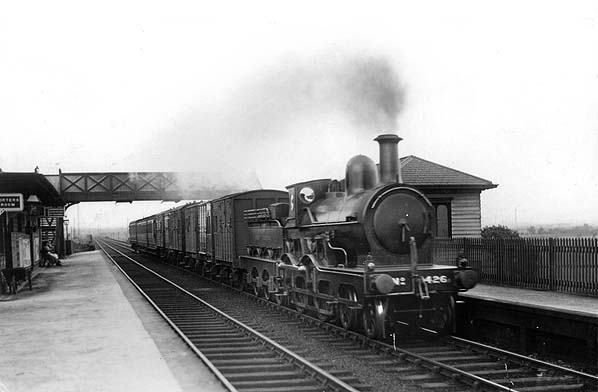
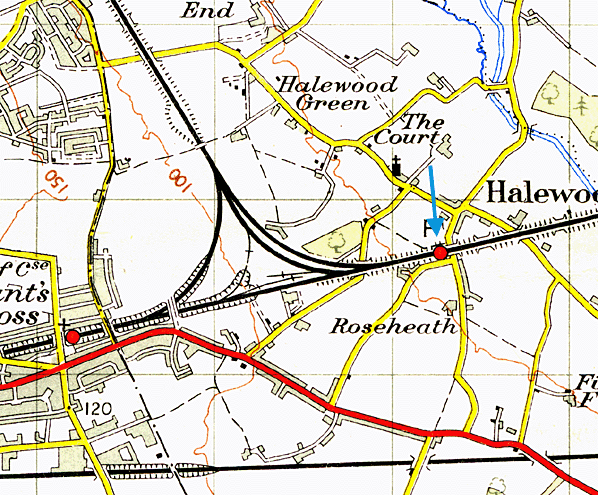
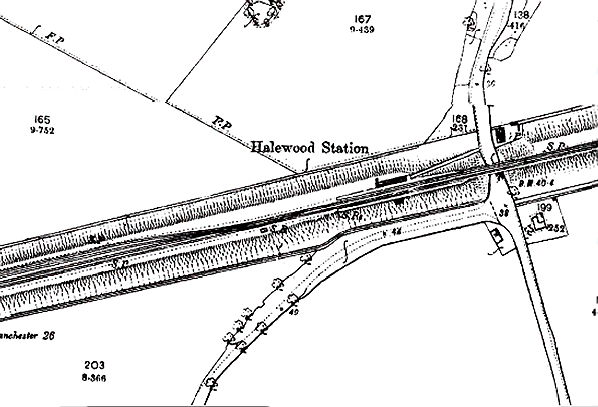
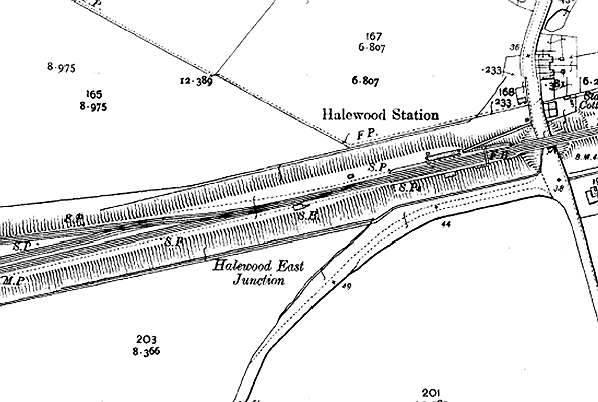
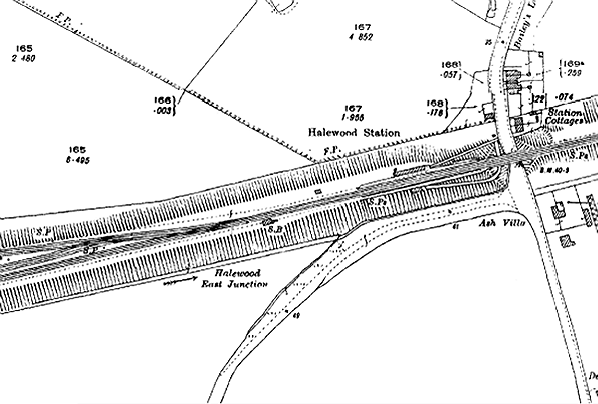
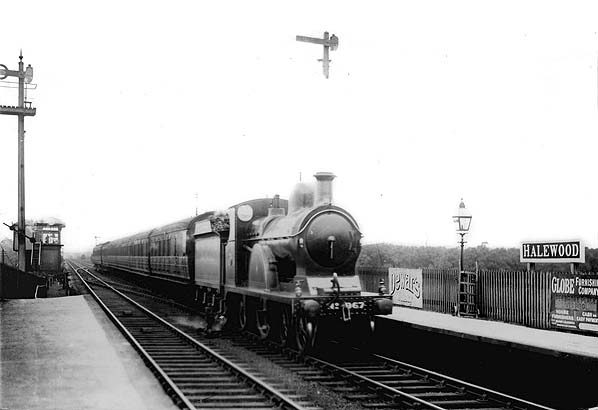
.jpg)
old1.jpg)
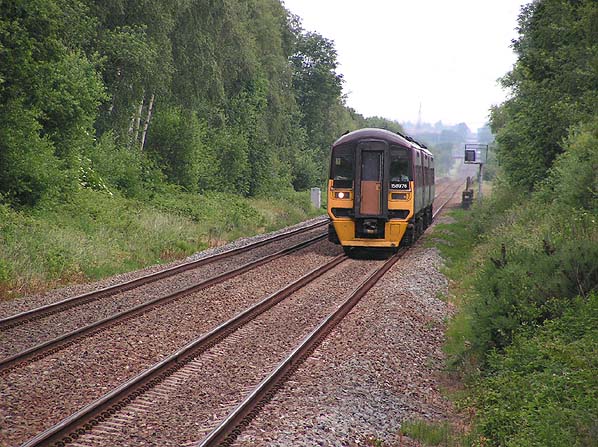
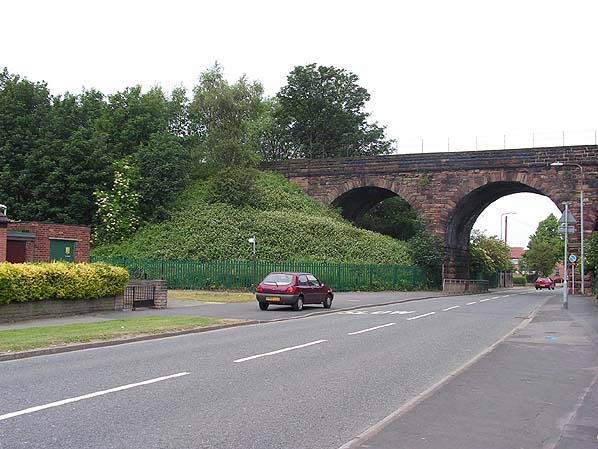
.jpg)
.jpg)
.jpg)



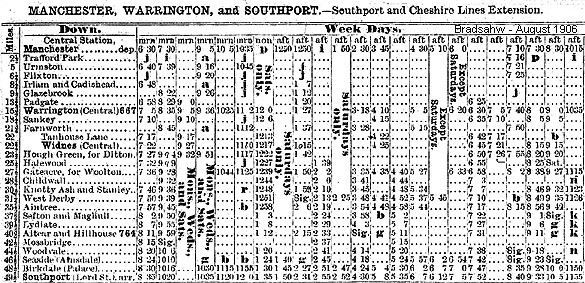





.jpg)
.jpg)
.jpg)
.jpg)

 Home Page
Home Page